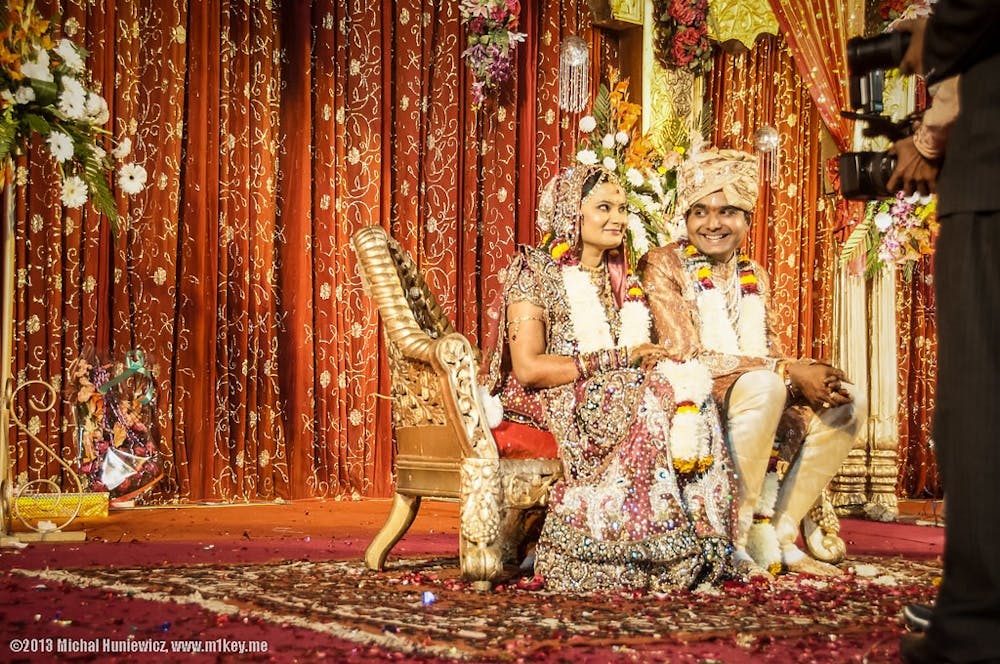When asked about how my parents met, I’ve conditioned myself to respond with, “It’s complicated.” I keep my language elusive and face straight to shut down any further questions they may have. I say “it’s complicated” because it is messy — it’s an inexplicable entanglement of traditional Indian marriage and true love, an assemblage of being found and finding each other.
Though they were introduced to each other through family connections in India, my parents took time to understand one another, cultivate respect, and appreciate one another’s future aspirations before getting married. My mother ranked at the top of her graduating class in physical therapy school and my father was an aspiring chemist. Both made their personal values, goals, and boundaries clear prior to marriage. Falling in love was a decision on their part, though first initiated by each of their families.
For me, their marriage is a colored mural of balance and spontaneity, of risk-taking and support. Yet I have a difficult time conveying their special bond to my friends and peers, since, in the traditional American sense, my parents’ marriage is antagonized as an “arranged marriage.” I don’t want to use the terms “arranged marriage” because they suggest something forceful, organized, and predetermined — as if my parents lacked the ability to control their fate. I want to honor their love and defend their story and how they truly learned about one another. The words “arranged marriage” just don’t achieve this purpose.
But there is no other way to describe my parents’ relationship. In India, the saying goes that there is “marriage and then there is love marriage,” as astutely noted by Sima Taparia, the Mumbai-based matchmaker and star of the hit Netflix series “Indian Matchmaking.” “Indian Matchmaking,” a reality TV show about the age-old tradition of arranged marriage in the Indian culture, follows Sima as she travels around the world to meet clients and introduce them to prospective spouses. The eight-episode series follows individuals as they approach first dates and conversations with the families of their prospective spouses. The notion of going to a matchmaker is not novel in India. In fact, a large majority of the country’s population elects to abide by this timeless tradition of “arranged marriage,” or being matched — whether it’s facilitated by professional matchmakers, great-aunts, well-known neighbors, or parents. Marriage, at its very core, becomes a structured family affair — an organized union of two groups of people, rather than of individuals.
Taparia, more lovingly known as “Sima Auntie” by her clients, makes no detour in her matchmaking process. Throughout the show, she collects what appears to be a hybrid of LinkedIn-Tinder profiles belonging to many hopeful, single Indians around the world and meets with her clients’ immediate and extended families. Through her process, Taparia takes audiences through a modern interpretation of arranged marriage in India. She asks clients and their families what they’re looking for in a partner. Sometimes, these questions are professional — what kind of job, hobbies, or education should your significant other have? However, other times questions can be outwardly discriminatory — should they be fair-skinned, tall, and lean? Taparia collects all of the nuances of her clients, their preferences, their homes, and families on pen-and-paper spreadsheets, checking off “desirable” traits and criticizing what she views as their shortcomings. At the crux of Taparia’s methodology lie antiquated beliefs about gender roles, colorism, and casteism.
Watching this show as an Indian American female, I have both praise for and concern with the show. “Indian Matchmaking” gets a lot right about the culture I’ve struggled with, but stops short of challenging practices I believe to be problematic in India. The show depicts colorist and casteist statements without addressing them — letting them fly by with no comment or criticism. It normalizes the domination of gender roles and discrimination plaguing countless individuals and, as such, encourages the continuation of the brutality many Indian women and girls face, trapped in a web of expectations and compromise. The show also fails to address the diversity of relationships and challenge the notion that marriage occurs only between men and women. By exclusively portraying heterosexual pairs, “Indian Matchmaking” erases the progress made by the LGBTQ+ community in India and extends disparities in the sphere of gender identity.
For many Western audiences, the dynamic of “Indian Matchmaking” mirrors that of shows akin to “The Bachelor” or “Love Is Blind,” which trace the love lives across an array of personalities. “Indian Matchmaking” similarly follows a plethora of individuals, such as 35-year-old lawyer Aparna from Houston, Texas, and Nadia, an event planner with Guayanese and Indian roots. Taparia’s clients share a common desire: to be matched with another Indian or Indian American who shares their personal values. However, in the show, issues long associated with arranged marriage in India are glossed over, unaddressed, and brushed to the side through Taparia’s character. These issues arise when Taparia insists that her female clients “adjust” and practice flexibility in their professional careers to accommodate a match; when males request for their matches to be thin or insist that women should not spend too much time outside of their homes; when family members only support matches made between the same castes, or socio-economic levels; and when the first request made by families is that the woman must be “light-skinned,” since having dark-skin is a negative quality by traditional standards. Instead of challenging these horrors deeply entrenched in the Indian marriage industry, Taparia perpetuates discriminatory traditions and does not steer clients away from these biases.
Yet, despite the show’s shortcomings, I commend it for sparking debates initiated by viewers on online platforms such as Twitter. From conversations about the problems inherent in traditional marriage practices to pressuring skin-cream companies to remove racialized skin color terminology from their branding, this show has pushed social progress and spearheaded conversation over misogynistic views.

Though I’m proud to see more Indian representation in the media sphere, I can’t help but fear that viewers assume that “Indian Matchmaking” is a profound depiction of Indian culture, because it is not. No one looks at Western reality shows as a realistic portrait of white American dating culture, yet many assume that “Indian Matchmaking” is representative of dating and relationships for all Indian people. The show marks Indian culture as being synonymous with parental pressure, family fights, and settling for forced relationships. However, viewing my parents’ marriage over the years, I’ve understood that healthy and respectful relationships can emerge from the Indian matchmaking system. My culture, though stained with imperfections, is also filled with mutual respect, memorable weddings, and honest pacts between individuals. It’s also a culture that values women, pushes individuals to pursue their aspirations, and commends social progress. But without more Indians appearing in Western media, shows like “Indian Matchmaking” will continue to normalize heavily contested and discriminatory practices all while portraying Indian culture to be burdensome.
There are slim pickings of media and content depicting Indian lives and relationships in our country’s predominantly white-dominated media landscape. As an Indian American, I’ve learned to view the entertainment industry from a safe distance, many times feeling that my identity is not accurately portrayed, and rather minimized to supporting characters and occasional appearances. As such, some might view “Indian Matchmaking” as a sliver of progress in Indian representation, but I think it is critical to also contextualize these constraints further by simultaneously depicting the joys of Indian heritage while also engaging in constructive conversations about its flaws.
“Indian Matchmaking” has certainly sparked important conversations that many of us need to be having in the South Asian community with our families. For me, it has enabled my parents and me to discuss what we choose to prioritize and internalize in regards to love and relationships. On the one hand, the show has prompted my parents to reflect on age-long traditions and the silent pressure they often felt as young adults to fulfill traditional roles. On the other hand, they’ve also been able to discuss their departure from societal expectations and the resources individuals can now use to challenge the dangerous constructs of casteism, classism, and light-skin superiority.
The tradition of arranged marriages, its toxic ideologies, and its regressive trends still exist in Indian society, putting pressure on women to compromise, instructing young adults to prioritize societal expectations, and preaching class divisions. These burdens are real and still unapologetically true, as depicted in “Indian Matchmaking.” However, they are certainly not representative of all of South Asian culture.









